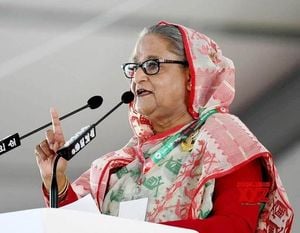California is once again at the epicenter of a fierce national battle over the future of congressional representation, as Governor Gavin Newsom and state Democrats push forward with an unprecedented redistricting plan. The move, designed to counter Republican-led gerrymandering efforts in Texas and other red states, has ignited a political firestorm, drawing sharp rebukes from Republicans and skepticism from good government advocates, while also exposing deep divisions within California itself.
On August 14, 2025, Governor Newsom took the stage at the Japanese American National Museum in Los Angeles, rallying supporters behind what he calls a defense of democracy. "Wake up, America," Newsom declared to a packed crowd, according to reporting from The Los Angeles Times. "Wake up to what Donald Trump is doing. Wake up to his assault. Wake up to the assault on institutions and knowledge and history. Wake up to his war on science, public health, his war against the American people." The governor's fiery rhetoric set the tone for a campaign that he and his allies say is a necessary response to President Trump’s push for aggressive redistricting in Texas and beyond.
At the heart of the controversy is a three-bill package—Assembly Constitutional Amendment 8 (ACA 8), Assembly Bill 604, and Senate Bill 280—crafted to redraw California's 52 congressional districts in a way that could deliver at least five additional seats to Democrats. The legislation, expected to pass the Legislature the week of August 19, 2025, would place the new maps before voters in a special election scheduled for November 4, 2025. If approved, these maps would be in effect for the 2026, 2028, and 2030 election cycles.
But there’s a catch: The plan is structured as a “trigger” measure, becoming operative only if Texas, Florida, or any other state adopts new congressional district maps after August 1, 2025, and before January 1, 2031, provided those changes aren’t mandated by a federal court order. Critics, however, have pointed out that the language of ACA 8 is broad enough to be activated by any state’s redistricting, not just Republican-led ones, potentially opening the door for future political maneuvering.
The redistricting fight is hardly one-sided. Just days after Newsom’s rally, California Republicans asked the state Supreme Court to pause the legislation, arguing that the public needs more time to review the sweeping changes. Representative Doug LaMalfa, whose rural northern district would be dramatically altered under the proposed maps, called the plan "an absolutely ridiculous gerrymander." The California Republican Party went further, branding the proposal a “MASTERCLASS IN CORRUPTION.” According to Axios, national Republicans have echoed these sentiments, with spokesperson Christian Martinez accusing Newsom of giving “a giant middle finger to every Californian.”
Republican outrage has been fueled by the fact that the new maps would supersede those drawn just four years ago by California’s independent redistricting commission, an institution established in 2008 with the explicit goal of keeping politics out of the process. Good government groups, including the League of Women Voters and Charles Munger Jr.—the billionaire who helped create the independent commission—have voiced strong opposition to Newsom’s plan. Even former Governor Arnold Schwarzenegger, a vocal Trump critic, weighed in, posting a photo of himself in a T-shirt reading “F*** the Politicians / Terminate Gerrymandering,” and calling for redistricting reform.
Yet, Newsom and his Democratic allies insist their hand has been forced by Republican actions elsewhere. President Trump has actively encouraged Texas Republicans to redraw their maps, writing in a Truth Social post, “Please pass this Map, ASAP.” Vice President JD Vance has also urged red states to take “decisive action” in the redistricting fight. In response, Democratic governors in states like Illinois and New York have floated similar strategies, with New York’s Kathy Hochul stating, "We are at war," and calling for a constitutional amendment to authorize new maps. Wisconsin Democrats are seeking to redraw their state’s maps through the courts before the 2026 midterms, while red states such as Missouri and Florida are also preparing for potential redistricting battles.
The stakes in California are high. Due to stagnant population growth, the state is projected to lose up to four congressional seats after the 2030 census. Some observers question whether Democrats, having secured more seats through the new maps, would willingly revert to the independent commission after 2030. The precedent, as noted by CalMatters, is not reassuring: after promising that a 2012 tax hike would be temporary, Democrats extended it for an additional 12 years, and similar pressures could arise to maintain legislative control over redistricting.
Public opinion, meanwhile, remains divided. Polling cited by The Los Angeles Times and Politico shows that nearly two-thirds of California voters prefer to keep redistricting away from the Legislature. This skepticism is rooted in a history of moderate pushback against liberal initiatives, such as the failed 2020 attempt to repeal affirmative action and the passage of Proposition 36, which increased penalties for theft and drug crimes. If voters reject Newsom’s plan in November, it could deal a severe blow to his national ambitions and the credibility of state Democratic leaders.
The redistricting war has also become deeply personal. The new maps threaten the seats of several high-profile Republicans, including LaMalfa, Ken Calvert, Darrell Issa, and Kevin Kiley. Kiley, for his part, has introduced a bill to ban all mid-decade congressional redistricting—a move that has attracted some bipartisan support but, so far, no co-sponsors. "This would stop a damaging redistricting war from breaking out across the country," Kiley argued in a press release.
Amid the political theater, the atmosphere has grown tense and, at times, surreal. During Newsom’s speech in Little Tokyo, masked Border Patrol agents appeared outside the museum—a site with deep historical significance as a former departure point for Japanese Americans sent to internment camps during World War II. Newsom viewed the show of force as an “authoritarian flex,” filing a Freedom of Information Act request to determine who ordered the operation. He later accused Trump of "advancing a playbook from the despots he admires in Russia and North Korea."
Democratic officials have framed the Election Rigging Response Act as a temporary measure designed to protect Latino representation and preserve the will of the people. Senator Lena Gonzalez emphasized that the Latino Caucus would "continue to work hard to further these goals, uplift Latino voices regardless of immigration status, and fight to protect hard fought gains." Supporters argue that the plan maintains the Citizens Redistricting Commission’s authority in the long run, only adopting new districts if other states act first.
As the November special election approaches, the outcome remains uncertain. Republicans are preparing a well-financed campaign to defeat the measure, while Democrats hope that voters will see their plan as a necessary response to what they describe as a national assault on democracy. For Newsom, the stakes are especially high: a victory could bolster his standing as a national leader and potential presidential candidate in 2028; a defeat could leave his political future in doubt.
In the end, California’s redistricting battle is about more than just lines on a map—it’s a reflection of the broader struggle over the rules of American democracy, and a sign of just how far both parties are willing to go to protect their interests in an increasingly polarized nation.





